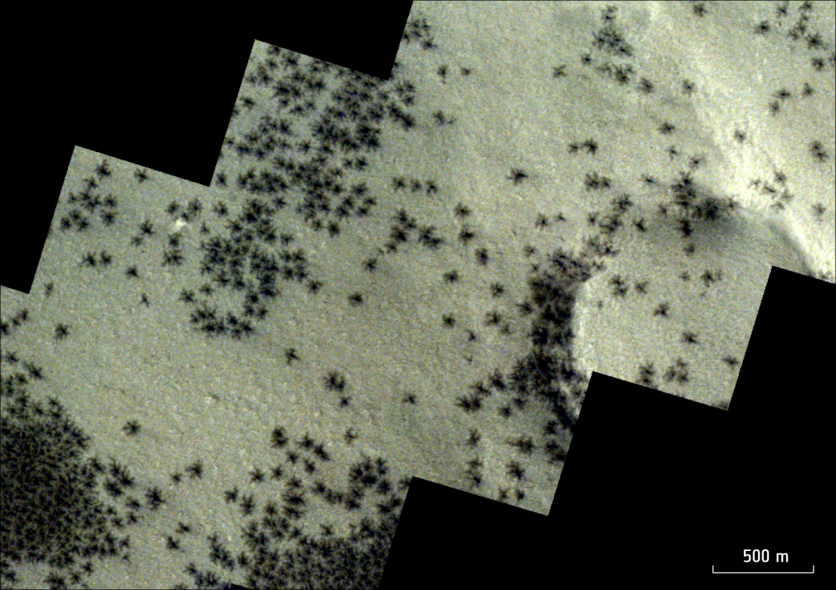New photographs captured by an orbiting satellite reveal an abundance of spiders on the dusty soil of Mars. These arachnid-like structures have black, thin characteristics generated by non-biological processes.
These characteristics are called "spiders" because they resemble arachnids. Thin streaks stretch outward, encircling a dark core splotch. They originate from seasonal variations on Mars, particularly the shift from severe cold to spring warmth, per Science Alert.

This image shows features known as ‘spiders’ near Mars’s south pole, as seen by the CaSSIS (Colour and Stereo Surface Imaging System) instrument aboard ESA’s ExoMars Trace Gas Orbiter.
Mars does not melt when temperatures increase, like Earth. When carbon dioxide freezes in the winter, dry ice forms. As spring arrives and temperatures rise, dry ice melts into gas, causing pressure under the surface.
When pressure is too high, tiny explosions fracture ice and discharge black, dusty stuff from below. These eruptions create black splotches up to a kilometer wide.
Who knew Mars had its own Machu Picchu? ⛰️🦙 These stunning images captured by DLR’s #HRSC show Angustus Labyrinthus, a region at the planet’s south pole. It features a landscape that resembles Earth’s Inca city 🌞, but whose formation remains a mystery. https://t.co/TjR4BqwSpg pic.twitter.com/ywDyDmeEOI
— DLR - English (@DLR_en) April 24, 2024
Understanding Mars' Surface Better with Express Orbiter
The High-Resolution Stereo Camera (HRSC) aboard the European Space Agency's Mars Express Orbiter photographed these black dots, which resemble freckles on the Martian dunes. The Color and Stereo Surface Imaging System (CaSSIS) instrument on ESA's ExoMars Trace Gas Orbiter shows the spidery tendrils beneath the surface ice in more detail.
The most recent image of Mars' Inca City, known for its resemblance to ancient ruins, depicts the dynamic Martian surface in spring with freckled areas.
The finding highlights Martian geological processes, sparking interest in its dynamic environment. For 20 years, the Mars Express has helped scientists understand Mars, per Mashable. The spacecraft has precisely surveyed Martian geography, examined its mineral makeup, and revealed its ecology.
Mars Express' latest flyovers produced stunning Machu Picchu-like photos. The southern polar region of Mars has revealed impressive landforms like Machu Picchu. Spaceship images also revealed araneiform terrain and spidery patterns in the Arctic region.
Methane Seeping from Mars
Earlier this week, NASA's Curiosity Mars Rover found methane flowing from the Gale Crater on Mars, surprising scientists.
As previosly reported by TechTimes, the US space agency claims that living organisms on Earth are primarily responsible for methane emissions, which surprises experts given that Mars hasn't shown signs of life.
However, Curiosity's Sample Analysis at Mars (SAM) instrument has regularly found methane around Gale Crater, Mars' only known methane source. This methane may be the result of geological activity involving water and rocks deep under Mars.
However, Gale Crater's methane behavior has presented unforeseen complications. NASA describes the gas as appearing mostly at night and dissipating throughout the day, with seasonal oscillations and occasional spikes up to 40 times above average.
The ExoMars Trace Gas Orbiter of the European Space Agency found no methane in the Martian atmosphere, per the report. Ashwin Vasavada, Curiosity's project scientist at NASA's Jet Propulsion Laboratory, calls for finding a story with exciting plot twists that represent Mars' methane dynamics.
Researchers are continuing to study the unique behavior of methane in the Gale Crater. New research suggests hardened salt deposits in the Martian regolith or soil may capture methane. Alexander Pavlov, a planetary scientist at NASA's Goddard Space Flight Center, found that temperature changes and mechanical stress from rover movements can degrade salt seals, releasing methane.
In 2017, Pavlov and his colleagues grew microorganisms in salt-infused Martian permafrost to test the concept. While the experiment was inconclusive, it demonstrated that ice soil melted and left a salt coating.
Related Article : NASA's Picture of the Day Unveils a Hot, Rapidly Spinning Star in Leo

ⓒ 2025 TECHTIMES.com All rights reserved. Do not reproduce without permission.




